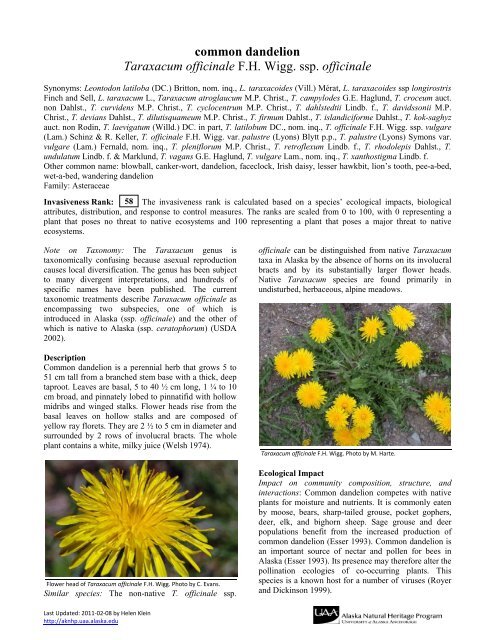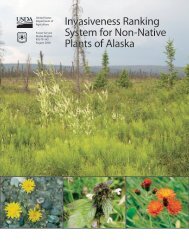common dandelion Taraxacum officinale F.H. Wigg. ssp. officinale
common dandelion Taraxacum officinale F.H. Wigg. ssp. officinale
common dandelion Taraxacum officinale F.H. Wigg. ssp. officinale
Create successful ePaper yourself
Turn your PDF publications into a flip-book with our unique Google optimized e-Paper software.
<strong>common</strong> <strong>dandelion</strong><br />
<strong>Taraxacum</strong> <strong>officinale</strong> F.H. <strong>Wigg</strong>. <strong>ssp</strong>. <strong>officinale</strong><br />
Synonyms: Leontodon latiloba (DC.) Britton, nom. inq., L. taraxacoides (Vill.) Mérat, L. taraxacoides <strong>ssp</strong> longirostris<br />
Finch and Sell, L. taraxacum L., <strong>Taraxacum</strong> atroglaucum M.P. Christ., T. campylodes G.E. Haglund, T. croceum auct.<br />
non Dahlst., T. curvidens M.P. Christ., T. cyclocentrum M.P. Christ., T. dahlstedtii Lindb. f., T. davidssonii M.P.<br />
Christ., T. devians Dahlst., T. dilutisquameum M.P. Christ., T. firmum Dahlst., T. islandiciforme Dahlst., T. kok-saghyz<br />
auct. non Rodin, T. laevigatum (Willd.) DC. in part, T. latilobum DC., nom. inq., T. <strong>officinale</strong> F.H. <strong>Wigg</strong>. <strong>ssp</strong>. vulgare<br />
(Lam.) Schinz & R. Keller, T. <strong>officinale</strong> F.H. <strong>Wigg</strong>. var. palustre (Lyons) Blytt p.p., T. palustre (Lyons) Symons var.<br />
vulgare (Lam.) Fernald, nom. inq., T. pleniflorum M.P. Christ., T. retroflexum Lindb. f., T. rhodolepis Dahlst., T.<br />
undulatum Lindb. f. & Marklund, T. vagans G.E. Haglund, T. vulgare Lam., nom. inq., T. xanthostigma Lindb. f.<br />
Other <strong>common</strong> name: blowball, canker-wort, <strong>dandelion</strong>, faceclock, Irish daisy, lesser hawkbit, lion’s tooth, pee-a-bed,<br />
wet-a-bed, wandering <strong>dandelion</strong><br />
Family: Asteraceae<br />
Invasiveness Rank: 58 The invasiveness rank is calculated based on a species’ ecological impacts, biological<br />
attributes, distribution, and response to control measures. The ranks are scaled from 0 to 100, with 0 representing a<br />
plant that poses no threat to native ecosystems and 100 representing a plant that poses a major threat to native<br />
ecosystems.<br />
Note on Taxonomy: The <strong>Taraxacum</strong> genus is<br />
taxonomically confusing because asexual reproduction<br />
causes local diversification. The genus has been subject<br />
to many divergent interpretations, and hundreds of<br />
specific names have been published. The current<br />
taxonomic treatments describe <strong>Taraxacum</strong> <strong>officinale</strong> as<br />
encompassing two subspecies, one of which is<br />
introduced in Alaska (<strong>ssp</strong>. <strong>officinale</strong>) and the other of<br />
which is native to Alaska (<strong>ssp</strong>. ceratophorum) (USDA<br />
2002).<br />
Description<br />
Common <strong>dandelion</strong> is a perennial herb that grows 5 to<br />
51 cm tall from a branched stem base with a thick, deep<br />
taproot. Leaves are basal, 5 to 40 ½ cm long, 1 ¼ to 10<br />
cm broad, and pinnately lobed to pinnatifid with hollow<br />
midribs and winged stalks. Flower heads rise from the<br />
basal leaves on hollow stalks and are composed of<br />
yellow ray florets. They are 2 ½ to 5 cm in diameter and<br />
surrounded by 2 rows of involucral bracts. The whole<br />
plant contains a white, milky juice (Welsh 1974).<br />
Flower head of <strong>Taraxacum</strong> <strong>officinale</strong> F.H. <strong>Wigg</strong>. Photo by C. Evans.<br />
Similar species: The non-native T. <strong>officinale</strong> <strong>ssp</strong>.<br />
<strong>officinale</strong> can be distinguished from native <strong>Taraxacum</strong><br />
taxa in Alaska by the absence of horns on its involucral<br />
bracts and by its substantially larger flower heads.<br />
Native <strong>Taraxacum</strong> species are found primarily in<br />
undisturbed, herbaceous, alpine meadows.<br />
<strong>Taraxacum</strong> <strong>officinale</strong> F.H. <strong>Wigg</strong>. Photo by M. Harte.<br />
Ecological Impact<br />
Impact on community composition, structure, and<br />
interactions: Common <strong>dandelion</strong> competes with native<br />
plants for moisture and nutrients. It is <strong>common</strong>ly eaten<br />
by moose, bears, sharp-tailed grouse, pocket gophers,<br />
deer, elk, and bighorn sheep. Sage grouse and deer<br />
populations benefit from the increased production of<br />
<strong>common</strong> <strong>dandelion</strong> (Esser 1993). Common <strong>dandelion</strong> is<br />
an important source of nectar and pollen for bees in<br />
Alaska (Esser 1993). Its presence may therefore alter the<br />
pollination ecologies of co-occurring plants. This<br />
species is a known host for a number of viruses (Royer<br />
and Dickinson 1999).<br />
Last Updated: 2011-02-08 by Helen Klein<br />
http://aknhp.uaa.alaska.edu
Impact on ecosystem processes: Common <strong>dandelion</strong> is<br />
one of the first colonizers to appear after disturbances<br />
and likely causes modest impacts to natural successional<br />
processes. It often achieves a peak in dominance within<br />
two to three years (Auchmoody and Walters 1988). In<br />
Alaska, this species often establishes in existing<br />
herbaceous layers, changing the density of the layer. It<br />
can form a new herbaceous layer on exposed mineral<br />
soil along river banks and roadsides.<br />
Biology and Invasive Potential<br />
Reproductive potential: Common <strong>dandelion</strong> reproduces<br />
sexually by seeds and vegetatively by shoots that grow<br />
from the root crowns (Whitson et al. 2000). Each plant<br />
can produce up to 5,000 seeds per year (Royer and<br />
Dickinson 1999). Seeds remained viable for up to 5<br />
years in soil samples from Montana (Bard 1952) and up<br />
to 9 years in experiments in Nebraska (Burnside et al.<br />
1996); seed banks are generally long-lived (Pratt 1984).<br />
Role of disturbance in establishment: In Alaska,<br />
<strong>common</strong> <strong>dandelion</strong> is primarily found on disturbed<br />
substrates, but it also establishes in meadows (M.<br />
Carlson – pers. obs.).<br />
Potential for long-distance dispersal: Each seed has a<br />
spreading pappus and weighs little; thus, wind can<br />
disperse seeds considerable distances. In tall grass<br />
prairie communities in Iowa, seeds were blown several<br />
hundred meters from the nearest source population<br />
(Platt 1975).<br />
Potential to be spread by human activity: Seeds are<br />
likely transported on vehicles and in horticultural<br />
materials (Hodkinson and Thompson 1997). They are<br />
<strong>common</strong> contaminants in crop and forage seeds<br />
(Rutledge and McLendon 1996).<br />
Germination requirements: Seeds must be in the top 2<br />
½ cm of soil to germinate (Royer and Dickinson 1999).<br />
Litter and mulch inhibit germination. Common<br />
<strong>dandelion</strong> germinates best in burned sites (Esser 1993).<br />
Seeds do not require cold stratification to germinate<br />
(USDA 2002).<br />
Growth requirements: Common <strong>dandelion</strong> is adapted to<br />
all soil types with pH levels from 4.8 to 7.5. This<br />
species can withstand temperatures down to -39°C. It<br />
requires 100 frost-free days to grow and reproduce<br />
successfully (USDA 2002).<br />
Congeneric weeds: Rock <strong>dandelion</strong> (<strong>Taraxacum</strong><br />
laevigatum), marsh <strong>dandelion</strong> (T. palustre), and showy<br />
<strong>dandelion</strong> (T. spectabile) are non-native species known<br />
to occur in North America. None are considered noxious<br />
weeds in the U.S. or Canada (USDA 2002).<br />
Legal Listings<br />
Has not been declared noxious<br />
Listed noxious in Alaska<br />
Listed noxious by other states<br />
Federal noxious weed<br />
Listed noxious in Canada or other countries (AB, MB,<br />
QC, SK)<br />
Distribution and Abundance<br />
Common <strong>dandelion</strong> grows in moist sites, lawns,<br />
meadows, pastures, and overgrazed areas. It also occurs<br />
in roadsides, waste places, and old fields. This species is<br />
considered a threat in montane forest and alpine zones<br />
in western Montana since it invades partially disturbed<br />
or undisturbed native communities and competes with<br />
conifer seedlings (Esser 1993).<br />
Native and current distribution: Common <strong>dandelion</strong><br />
(<strong>Taraxacum</strong> <strong>officinale</strong> <strong>ssp</strong>. <strong>officinale</strong>) is native to<br />
Eurasia but has become naturalized throughout North<br />
America. It has been found in all 50 states of the U.S.<br />
and most Canadian provinces. This species has also<br />
been introduced into southern Africa, South America,<br />
New Zealand, Australia, and India (Hultén 1968, Esser<br />
1993). Common <strong>dandelion</strong> has been reported from all<br />
three ecogeographic regions of Alaska (Hultén 1968,<br />
ALA 2004). It invades meadows in Glacier Bay<br />
National Park and Preserve and river bars along the<br />
Nenana River and Stikine River (M. Shephard – pers.<br />
obs.). Common <strong>dandelion</strong> colonizes burned areas in the<br />
Kenai Peninsula (P. Spencer – pers. obs.). Common<br />
<strong>dandelion</strong> has been documented from all three<br />
ecogeographic region of Alaska (Hultén 1968, UAM<br />
2003, AKEPIC 2010).<br />
Pacific Maritime<br />
Interior-Boreal<br />
Arctic-Alpine<br />
Collection Site<br />
Distribution of <strong>common</strong> <strong>dandelion</strong> in Alaska<br />
Management<br />
Dandelion can be readily controlled with herbicides and<br />
spring burning. Hand pulling and cutting are generally<br />
ineffective because plants readily resprout from the<br />
caudex (Staniforth and Scott 1991).<br />
References:<br />
AKEPIC database. Alaska Exotic Plant Information<br />
Clearinghouse Database. 2010. Available:<br />
Last Updated: 2011-02-08 by Helen Klein<br />
http://aknhp.uaa.alaska.edu
http://akweeds.uaa.alaska.edu/<br />
ALA. University of Alaska Herbarium. Arctos on line<br />
database.<br />
http://arctos.database.museum/home.cfm.<br />
Accessed 10 November 2004.<br />
Auchmoody, L.R. and R.S. Walters. 1988. Revegetation<br />
of a brine-killed forest site. Soil Science<br />
Society of America Journal. 52: 277-280.<br />
Bard, G.E. 1952. Secondary succession on the Piedmont<br />
of New Jersey. Ecological Monographs.<br />
22(3):195-215.<br />
Burnside, O.C., R. G. Wilson, S. Weisberg, and K.G.<br />
Hubbard. 1996. Seed longevity of 41 weed<br />
species buried 17 years in Eastern and Western<br />
Nebraska. Weed Science. 44: 74-86.<br />
Carlson, M. L., Assistant Professor, Alaska Natural<br />
Heritage Program, University of Alaska<br />
Anchorage, 707 A Street, Anchorage, Alaska.<br />
Tel: (907) 257-2790 – Pers. obs.<br />
eFloras. 2008. Published on the Internet<br />
http://www.efloras.org [accessed 18 October<br />
2010]. Missouri Botanical Garden, St. Louis,<br />
MO & Harvard University Herbaria,<br />
Cambridge, MA.<br />
Esser, L. L. 1993. <strong>Taraxacum</strong> <strong>officinale</strong>. In: Fire Effects<br />
Information System, (Online). U.S. Department<br />
of Agriculture, Forest Service, Rocky Mountain<br />
Research Station, Fire Sciences Laboratory<br />
(Producer). Available:<br />
www.fs.fed.us/database/feis/<br />
Hodkinson, D., K. Thompson. 1997. Plant dispersal: the<br />
role of man. Journal of Applied Ecology, 34:<br />
1484-1496.<br />
Hultén, E. 1968. Flora of Alaska and Neighboring<br />
Territories. Stanford University Press, Stanford,<br />
CA. 1008 p.<br />
Invaders Database System. 2010. University of<br />
Montana. Missoula, MT.<br />
http://invader.dbs.umt.edu/<br />
ITIS. 2010. Integrated Taxonomic Information System.<br />
http://www.itis.gov/<br />
Platt, W.J. 1975. The colonization and formation of<br />
equilibrium plant species associations on<br />
badger disturbances in a tall-grass prairie.<br />
Ecological Monographs. 45: 285-305.<br />
Pratt, D.A., H.E. Ahles, R.C. Bell. 1984. Buried viable<br />
seed in a ponderosa pine community. Canadian<br />
Journal of Botany. 62: 44-52.<br />
Royer, F., and R. Dickinson. 1999. Weeds of the<br />
Northern U.S. and Canada. The University of<br />
Alberta press. 434 pp.<br />
Rutledge, C.R., and T. McLendon. 1996. An<br />
Assessment of Exotic Plant Species of Rocky<br />
Mountain National Park. Department of<br />
Rangeland Ecosystem Science, Colorado State<br />
University. 97 pp. Northern Prairie Wildlife<br />
Research Center Home Page.<br />
http://www.npwrc.usgs.gov/resource/plants/exp<br />
lant/index.htm (Version 15DEC98).<br />
Shephard, M. , Vegetation Ecologist, USDA, Forest<br />
Service, Forest Health Protection, State and<br />
Private Forestry, 3301 C Street, Suite 202,<br />
Anchorage, Alaska 99503 Division. Tel: (907)<br />
743-9454 - Pers. com.<br />
Spencer P. Ecologist, National Park Service, Alaska<br />
Region - Biological Resources Team, 240 W.<br />
5th Ave, #114, Anchorage, AK 99501 tel: (907)<br />
644-3448 – Pers. com.<br />
Staniforth, J.G. and P.A. Scott. 1991. Dynamics of weed<br />
populations in a northern subarctic community.<br />
Canadian Journal of Botany. 69: 814-821.<br />
UAM. 2010. University of Alaska Museum, University<br />
of Alaska Fairbanks. Available:<br />
http://arctos.database.museum/home.cfm<br />
USDA (United States Department of Agriculture),<br />
NRCS (Natural Resource Conservation<br />
Service). 2002. The PLANTS Database,<br />
Version 3.5 (http://plants.usda.gov). National<br />
Plant Data Center, Baton Rouge, LA 70874-<br />
4490 USA.<br />
Welsh, S. L. 1974. Anderson’s flora of Alaska and<br />
adjacent parts of Canada. Brigham University<br />
Press. 724 pp.<br />
Whitson, T. D., L. C. Burrill, S. A. Dewey, D. W.<br />
Cudney, B. E. Nelson, R. D. Lee, R. Parker.<br />
2000. Weeds of the West. The Western Society<br />
of Weed Science in cooperation with the<br />
Western United States Land Grant Universities,<br />
Cooperative Extension Services. University of<br />
Wyoming. Laramie, Wyoming. 630 pp.<br />
Last Updated: 2011-02-08 by Helen Klein<br />
http://aknhp.uaa.alaska.edu

















